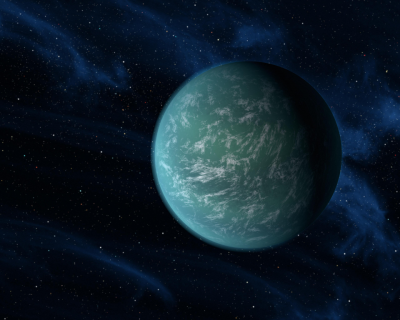
Could we live there if we had to? An artist's concept of the planet designated Kepler 22b. Image: NASA.
The movie opens Nov. 7 and is the product of Batman trilogy writers Christopher and Jonathan Nolan. It stars Matthew McConaughey, Jessica Chastain and Anne Hathaway and has already been described as a blockbuster -- before anyone has seen it. But the movie raises a troubling question: Could we find another world to inhabit?
As it turns out, a nonprofit group is dedicated to teasing out the truth about life on other planets. The SETI Institute – the acronym stands for Search for Extraterrestrial Intelligence -- in Mountain View, California, has a staff of scientists and a stated mission of understanding “the origin, nature and prevalence of life in the universe.”
Beyond that, NASA has mined data from the Kepler Space Telescope. Launched in 2009, Kepler searched the Milky Way for planets in the habitable zone -- the distance from a star in which the temperature of an orbiting planet might be suitable for water.
The Kepler mission took its name from Johannes Kepler (1571-1630), the astronomer noted for writing laws of planetary motion. The Kepler telescope is no longer operational, but it provided four years of data for scientists by measuring variations in the brightness of more than 100,000 stars every 30 minutes.
Here are five findings from scientists searching for signs of life on other planets:
- December 2011: The Kepler mission confirmed its first planet in the habitable zone. Designated Kepler-22b, the planet is 2.4 times the size of Earth. While uncertain about whether it actually is habitable, scientists said the planet's discovery put them a step closer to finding Earth-like planets.
- November 2013: Scientists announced that about 70 percent of the stars observed by Kepler show planets. Furthermore, 1 in 5 is orbited by an Earth-sized planet in the “habitable zone.”
- February 2014: NASA's Kepler mission announced the discovery of 715 planets. These newly verified worlds orbit 305 stars. Scientists said the multiple-planet systems would be fertile grounds for studying individual planets and the configuration of planetary neighborhoods.
- April 2014: Scientists using the Kepler telescope announced that they had discovered the first Earth-like planet in the habitable zone. The discovery of the planet designated Kepler 186f confirmed that an Earth-sized planet existed in the habitable zone around another star. Going there wouldn’t be easy: it is about 500 light-years from Earth in the constellation Cygnus. But even if we could get there, it wouldn’t be like living on Earth. Kepler-186f orbits its star once every 130-days, according to NASA. Its star is a red dwarf about half the size and mass of our sun. One scientist cautioned that just because a planet is in the habitable zone, that doesn’t mean it is habitable.
- June 2014: Researchers from the University of New South Wales in Australia said they had discovered a supersized earth. The planet is much like ours but with a mass five times as large, according to the university’s news office.
NASA In Brief -- Scientists discover 715 new worlds; spacesuit helmet leak probed